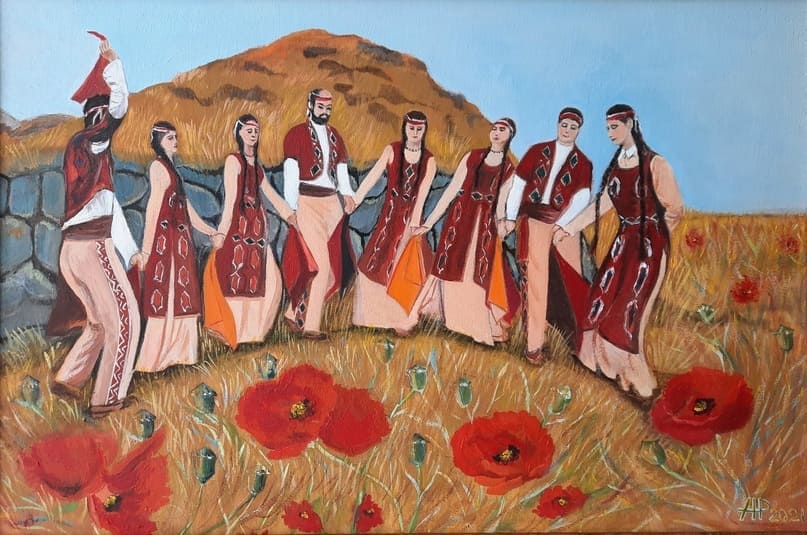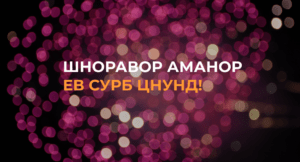In popular culture, there is a famous quote attributed to the American writer Mark Twain: “Dance like nobody is watching.” Indeed, it makes dancing easier and more free. This quote, however, does not work for the performers of Armenian folk dances: they will definitely be watched at because the Armenian dances can be smooth or energetic, feminine or masculine, but always impressive. It is impossible to take your eyes off the dancers. In this article we will try to figure out what kind of Armenian national dances exist and the story behind them.
Contents
- Things you need to know about Armenian national dances
- Types of Armenian national dances
- Main Armenian national dances
- Women's national dances
- Armenian dances today
Things you need to know about Armenian national dances
The national dance originated in Armenia in prehistoric times and was an important part of both everyday life and festivities. The work in the field or harvesting was not complete without a dance. They saw off their relatives to a long journey with dances. They danced all day at weddings, before a battle or after the victory. Such wide variety of dances was associated with rituals, traditions and faith. It was also a way to express emotions, be it sorrow or joy. A special meaning was put in dance: they drove away evil spirits with one dance and called for good ones with another, the third gave them strength.
It mattered not only on what occasion, but also who exactly danced. Dances were male, female, mixed, differed in age, position in society and the number of dancers. For example, men performed military dances, young people performed comic dances and widows and widowers were not allowed to dance in a circle with the bride and groom at a wedding.
There is not a single extra movement in a national dance. So, for example, the smoothness of a girl's hands could convey the flapping of a bird's wing, and the clap of men's hands could convey a collision with an enemy. While dancing women looked graceful and men looked defiantly: they jumped, sat on their knees, stomped, moved quickly.
Some dances became entire performances: they dressed up in bright costumes, took various attributes: masks, weapons, scarves.
Music was an important part of a dance. It was performed on folk instruments: duduk and zurna and darbuk. During a dance, texts were sometimes read aloud which were associated with rituals. In the Armenian tradition the dance, as a rule, increased in pace every minute, the movements went from simple to complex.
We can say that the whole life of the people, their history, values, prayers, happy and sad days are conveyd in their dances. Let's see what groups the Armenian national dances are divided into.
Types of Armenian national dances
There were many types of traditional dances, for example, totemic and hunting, comic and pantomime, labor and lyrical, epic, etc. Let's take a closer look at some of them.
Imitative dances
Imitative dances were associated with pagan ideas of the world. Armenians put on masks, scarves and clothing made from animal skins to dance in honor of their ancestors and protect themselves from evil.
Each imitative dance was characterized by its own movements, repeating the habits of this or that animal or bird. For example, when they danced "Tavukh pari" and "Kryngotsi"— "Chicken" and "Crane" dances, respectively, they lined up; the first was a dancer who represented the leader. He seemed to guard the flock, he showed the right movements and sometimes lagged behind to "protect" the others. They also imitated how birds fly, peck grain, build nests, protect chicks and mothers in such dances .
It is interesting to watch the collective dance in honor of bear. They take the partner by one hand, and put the other one under the left bent knee and jump on the right leg. It certainly does not look as graceful as the "Jeirani" dance, in honor of antelope. The movements here are smooth, unhurried, involve the dancer's hands. The woman dances with her head held high trying to imitate the elastic gait of the animal.
Household dances
It were not only feasts and holidays that were accompanied by dancings but also work. The butchers had their own dance, "Kasab havasi", those who were engaged in crushing danced "Dyngo" ("Mortar") and "Ekek tsetsenk sokh u sekhtor" ("Let's crush onions and garlic"). The shepherds danced with their bells, staffs and lassoes.
Women danced "Shaler", as if processing wool. There were also dances for collecting flowers, harvesting, doing housework and playing near the water.
Ritual dances
Ritual dances were timed to coincide with important events, danced on a specific day and in a specific place. The start of the harvest collecting had its own dance; on cattle-breeding holidays they danced "Kochari" and "Ververi"; in spring the girls picked flowers, told fortune and danced "Dzhan-Gyulyum".
They danced all day at the wedding so that the young family would be happy, rich, fertile and protected from evil. Each dance had its place, time and performers. So, when the newlyweds were brought into the groom's house, the mother-in-law danced on the threshold. She laid thin lavash bread crosswise on her daughter-in-law's head and shoulders, showered her with sweets, dried fruits, nuts and coins, and kissed the couple on the eyes.
In the evening, after the wedding, the married senior representative of the bride's family danced. The dance “Khynamu par” was meant to evoke the affection of the ancestors of the family and members of the community.
Everyone (except widows and widowers) danced "Momerov par" (Dance with candles). Married couples received candles, stood in a circle and held their little fingers. The bride and groom danced in the center of the circle as if being protected from evil spirits. The newlyweds walked three circles, and everyone else danced until the fire burned out. Candles then remained with the newlyweds and were lit on solemn days, during childbirth and christening.
Comic dances
Comic or joke dances were performed mainly by men. These were humorous dance-games. No more than eight young men participated in the "Ludki" dance. They imitated buffoons, jesters, amused the audience, dancing lightly and with a proud posture. The dance "Poplyancho" parodied a dancer on a tightrope. The "Shalakho" dance had many variations. In some areas of the country it was performed by men dancing with a scarf: they showed off how skillfully they could toss a scarf, throw it on their arm, on their shoulder. It was a very cheerful dance. This version was staged in "Gayane" ballet. In other areas "Shalakho" had a different meaning: men competed in the dance and fought for the girl's headscarf.
Road dances
Road dances were performed on the way somewhere or during the farewell. They danced when they escorted travelers to another village, to a pilgrimage, to and from the house of the bride. The dance was often accompanied by chants and music. People of any age and status lined up in the "Pochov" road dance. The leader of the line held a handkerchief or, when it got dark, a torch to illuminate the road and protect from evil spirits. They danced making zigzags, circles to cover their tracks and confuse evil spirits. And they never came back the same way.
Military dances
Military dances were performed only by men. They imitated the sounds of battle by clapping their hands and stomping their feet as, for example, in the "Tsap par" ("Clap dance"). The scene of the battle was conveyed by movements back and forth and left and right, by jumping and kneeling. The dancers changed places, circled. Hand-to-hand combat was shown by clapping hands with partners, as in the "Yarkhushta" dance.
They could use real shields and sabers, but often real weapons were replaced by sticks, or they were simply imagined. In "Traghagh" ("Dance with sabers") men demonstrated the handling of sabers (or sticks imitating them). This dance was performed to fill young people with courage before the battle. The "Saber Dance" is one of the most beautiful parts of "Gayane" ballet.
In "Khasab Aghasi" dance men fought with imaginary knives. They frightened enemies with knives and sharpened them on theri armor.
In many dances the enemy was considered defeated when the hat was knocked off his head.
There were not only group dances, but also duets and solo dances. When a warrior performed alone he showed how skillfully he wielded weapons.
They performed military dances before the battle in order to tune in to the battle, to gain courage. The rhythm of the dances was fast and increased towards the culmination, the zurna sounded piercingly, the drums accelerated.
Main Armenian national dances
After talking about the types of dances, we will consider the main ones and tell about their history and meaning.
National dances from the movie "Men":
"Echmiadzin"
There was a dance in honor of the god of sun in pagan times. It was performed in the province of Karin. Resembling the shape of the celestial body the dancers stood in a circle. When they moved forward and narrowed the circle, it meant sunset, when they moved out of the circle, widening it, it meant sunrise. They took 12 steps, six in different directions. Stepping to the right and inward gave good luck to the community, and by stepping to the left, the dancers drove away the negative energy. The number 12 is not accidental here: it symbolized the signs of the zodiac. The dancers bowed to them as a sign of respect and reverence.
With the advent of Christianity the dance was interpreted differently. It was named "Echmiadzin" after the first Christian church in Armenia. The essence of worship and prayer remained, but the 12 steps now meant the 12 apostles.
"Papuri"
This is a cult dance which is translated as "to beat, punish, suffer." It was performed to drive away evil spirits or when misfortune overtook the community. The dancers showed their strength, courage and scared away the dark forces by loudly clapping their hands and stamping their feet. They stood in a circle, held tightly to each other's shoulders and moved to the right and left. Usually the dance was performed by men, but sometimes women also joined. As the music got faster the women left the circle and then the men no longer walked but jumped. Thus, the community showed its unity, lack of fear and drove away evil forces.
"Kochari"
The most famous Armenian dance is "Kochari". It is associated with the cult of the ram (“koch” - a ram), so the movements of the dancers repeated those of the animal. A man with a handkerchief in his hand stood the first and waved it indicating a change of a movement. It was necessary to hold on to the shoulders and make sharp movements leaning back and forward, then jumping. Each region had its own "Kochari". Somewhere it was considered more warlike and was performed by men before a battle or after a victory. In other places, "Kochari" was associated with the hope of fertility, so the movements were smoother, the hands were raised to the sky.
"Kochari" appeaared in a historical film in 1945. Joyful Armenian soldiers danced "Kochari" near the walls of the Reichstag. The military Arshaluys Saroyan wrote a poem, "The Dance of Victory"dedicated to this event, which you can listen to in this chronicle:
In 2017, the "Kochari" dance was included in the UNESCO Intangible Cultural Heritage List.
"Kochari" is still danced on the streets of Armenia and on holidays. Now it unites men and women of different generations and statuses.
"Berd"
Once upon a time there was a game called "Gmbetaghagh" ("Game in the dome"). Its essence was to hold hands and climb onto each other's shoulders, apparently forming a dome. Over time, in the city of Vaspurakan, this game turned into a military dance called "Berd", which means a fortress. Men conveyed the process of building a fortress with movements and at the end stood on each other's shoulders, like they did in the game before.
"Yarkhushta"
The military dance "Yarkhushta" ("Comrade in arms") was also danced only by men. It originated in the province of Sasun. The soldiers performed "Yarkhushta" before the battle to raise their morale. They depicted future fights in the dance. The men stood opposite each other, walked towards each other, and when they came near, they clapped their hands imitating the battle sounds.
Women's national dances
Perhaps the main female Armenian dance is “Uzundara”. This is a wedding dance of the bride, which came from Artsakh. The girl performed it alone or with her friends. The movements are restrained, smooth, mostly hands are involved. The dance has the sad meaning of farewell to her relatives and parents.
Previously, the entire wedding was accompanied by a variety of ritual dances. Many of them are not performed now, but the "Uzundara" dance has remained.
Here is, for example, how modern brides dance:
The dance "Shavali" is also called the dance of the mother-in-law. It is performed at the wedding by the parents of the bride and groom, and the rest of the guests, mostly adults, join them. The dancers hold on to their little fingers, their arms are bent at the elbows, they walk in a circle first in one direction, then in the other direction.
Armenian dances today
Since the mid-20th century the Armenian national dances, which were preserved, began changing. Now, for example, women can dnace traditionally male military dances. They don’t look at the age of the dancers either: a child can dance along with an elderly person. This is because the original symbolism and purpose of many dances are gone. The main thing, which remains, is the desire of the people to get together in order to feel unity, to see their friends, to make sure that they are not alone and, of course, to have a lot of fun.
Armenians remember about their intangible heritage. Traditional wedding dances are still danced today. Some Armenian schools teach national dances. There is a proposal to teach military dances to servicemen in the army.
Folk dances are performed by the State Ensembles "Barekamutyun" and "Berd". And in 2005 the Folk Song and Dance Ensemble "Karin" held a free dance lesson for everyone for the first time. The participants liked this initiative so much that the lessons have been held on the last Friday of every month since then. In summer these are open air lessons held in Cascade. Thus, even more people join the traditions and culture of Armenia.
Another interesting dance event is the “Ari Pari "Kochari” project, which means “Let's dance "Kochari”. In 2018 a global flashmob was organized in honor of the 2800th anniversary of the Armenian capital Yerevan and the 100th anniversary of the First Armenian Republic. Representatives of the diaspora around the world gathered in parks, squares and danced "Kochari". So Armenians from different countries could feel closer to each other, celebrate, and, at the same time, tell everyone around about their traditions. This project continues to this day and every year they choose a new occasion to get together and dance.
Flashmob in Cyprus:
It's amazing how much a dance can tell about the Armenian people and how wonderful it is that people do not forget their traditions, love them and try to preserve them. You can learn more about Armenian traditions in this article. And if you want to learn how to perform folk dances, follow the announcements of classes on the website Move2Armenia Culture.
















Add a comment